Also - See photos and comments from the
CTIA 2010
CES & ICCE
2010 - -
Showest 2010 - - CableTec
2009 |
| Get on our distribution list - click here |
| Click on Photos to Enlarge |
| Scroll Down to See Everything |
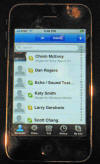 |
The Skype iPhone app went on the App Store today (Mar
31, 2009), and is already the #1 popular (free) app. Most
useful if you are dialing internationally because you
can make a phone call over WiFi (but not 3G). You
can also text to people without paying the carrier. |
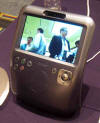 |
This is an Asus AiGuru SV1 video phone that was introduced about half a
year ago. Cute and maybe even useful for heavy video
Skype users. |
|
|
Truphone is an alternative to the Skype iPhone app, but it
also works with Skype and allows voice calls over the
carrier (not just WiFi) |
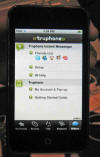 |
Wilson makes this signal booster for your iPhone in your
car. An external antenna is connected via the cradle.
Takes a little installation work. Sort of "old school"
meets the iPhone. About $279. |
 |
 |
Slacker radio has this free app that gives you all kinds of
radio theme stations (you listen to commercials unless you
buy the premium service. You can indicate your
preferences in music and they help you select what to listen
to. They claim it is better than Pandora. |
 |
Vanu offers a software solution that lets multiple carriers share the same tower. This means fringe areas might
be better covered because carriers can share costs and
tower placement. |
|
Abbyy sells OCR software to app developers. Take a
photo of a business card and the data goes into your contact
list. Other applications, such as translators, exist.
Reading a business card might require a phone with a fairly
good camera (2M pixel or better with good auto focus) |
 |
Hantech from Canada makes Tablo, a device that converts your
laptop display into a digitizing tablet by reading the
special pen via a sensor on the top of the display.
This not a phone app, but clever nonetheless. Not sure
how people will feel about drawing on their notebook screen,
but it is only about $99 US. |
 |
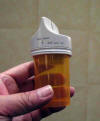 |
The Vitality GlowCap lets your pharmacy monitor if you have
taken your pills. If you forget, the cap glows, then
chirps, and eventually you get a phone call. The cap can
communicate to a base station. A version can use
cellular phone communications. The idea is
that the pharmacy builds the cost of this reusable cap into the
cost of your pills. The battery lasts 6 months for the
WiFi version. Not yet part of the Continua effort. |
 |
Motorola just introduced this Bluetooth stereo headset. It
will be available first with Verizon, and later with others.
Price range is $50 to $75. |
Nokia has a content sharing site called OVI. With an
application built into the phone a user ca upload photos and
videos for others to see.
Now they are starting the OVI Store so you can buy apps for
your Nokia phone. |
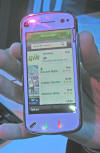 |
 |
Nokia is trying out some non-phone consumer products.
|
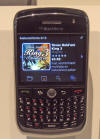 |
Perhaps a bit more well publicized is Blackberry's App
World. It works much like Apple's App Store, but
Blackberry enforces a minimum $2.99 price for non-free apps
to help out the developer community. Further, they
give an 80/20 split to the developer instead of Apple's
70/30 split. |
 |
Every time we visit WiMAX booths there is a new name. At
one point it was Xohm. Then it was Clearwire. Now
Clearwire has changed its name to simply Clear. The device
shown here is a WiFi router that works with a WiMAX modem to
create an instant Personal Hotspot. About $139. |
|
. |
Samsung showed their wireless Internet device called the
SWD-M100, What distinguishes this device is that it
works with WiMAX, WiFi and Bluetooth. It also
has two cameras - one for photos (3MP) and one for video
calls (0.3 MP). This uses Windows Mobile 6.1 Classic |
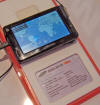 |
 |
|
Qualcomm is about to offer a Netbook that they call Snap
Dragon. Among the things to note - they plan to offer
Google's Android operating sytem on it. Expect to see
it in the Q4 time frame for about $400. |
  |
Qualcomm is also going to offer Kayak, a browser that connects
directly to the Qualcomm wireless network. You can only
browse the web. No real native applications, except you
can run apps on the web itself. This is aimed at 3rd world
countries and they hope to sell it for under $200. |
 |
 |
LG showed this watch phone before. Now they are
showing more styling variations. These will be
available in Q4 in Europe. |
 |
LG is working on LTE phones (4G, alternative to WiMAX).
This is a photo of a working LTE phone prototype. |
|
LG won the battle for mobile ATSC television. Over the
months they have shown various working models. If you
are not familiar with this, unlike some services, you get
locally broadcast TV stations on your phone for free. |
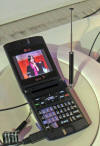 |
Docomo and Fujitsu showed an interesting concept - a separable
phone. The unit shown on the top is a working prototype,
while the ones on the bottom are not. What can you do with
such a phone? You can talk with one half while looking at
your calendar, etc. in the other have. You can use one
have as a remote control for the other as you watch videos. |

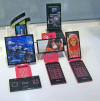 |
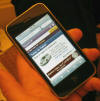 |
Yahoo just went live (April 1) with their portal app for the
iPhone. It is a bit like their portal site for
browsers on PCs, except that it also integrates some of the
phone functions into the user interface. It is
generally known as Yahoo Mobile. (You might not be
able to get this app from the Apple Store) |
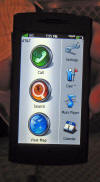 |
Now that the iPhone will soon have
turn-by-turn instructions in it, Garmin, maker of portable
navigation products, is working with Asus to bring out a phone.
Why? They claim that it will tightly integrate everything
it does with geo-tagging. Available soon. |
|
iVisit offers a mobile video conferencing service.
Talk and see up to 8 people on your phone. A version
is set up for telemedicine. It runs on Windows Mobile,
but they will soon have versions for other popular phones.
This is a $5/month service. |
 |
Wi-Ex has been offering cell phone boosters for a few years.
The product is call zBoost, and it works fairly well (we have
one). However, the older model
forces you to place the repeater unit several feet from the
antenna to avoid interference. Now they have come up with
the zBoost-One, which puts the repeater and antenna into one
package. Slick trick. $249. |
 |
 |
Diaspark is a name that you won't hear about, but you might
soon notice shopping flyers (the kind you get in the
newspaper) from their customers (e.g. ShopRite and Hy-Vee).
Click on a product and learn more. Perhaps there might
even be an electronic coupon there. |
 |
Tri-Spec is making Bluetooth headsets fashionable. These
look like regular shades (comes in black, too), but you can be
talking to your friends on your phone without looking like you
have a growth on your ear. |
|
Taking a long hike in the mountains, but want to stay in
touch with your phone? Bring this Powerfilm Solar
charger and plug in a USB cable for your phone. Also
charges two AA batteries. Puts out 3W (larger sizes
exist). Roll it up and stuff it into your backpack when done
(it is flexible) $100. |
 |
Want to engrave your phone (even your iPhone)? For a price
of between $10 to $50 (depends upon phone) you can order up a
custom laser etched cover from Coveroo. If you have an
iPhone, you need to send it in - otherwise, you simply order via
the web and a new phone plate is mailed to you. |
 |
|
|
Or, if you are into the warm and fuzzy - get a Funfriends
cover for your phone. These look like miniature
stuffed animals. Not for use during most business
meetings. These will be available for about $10. |
 |
|
| |































